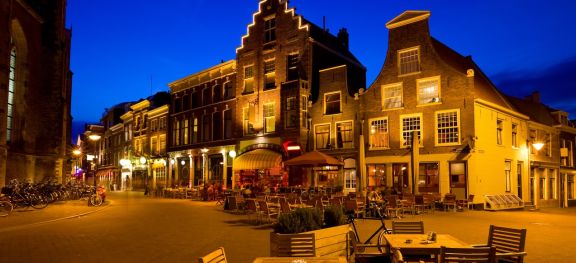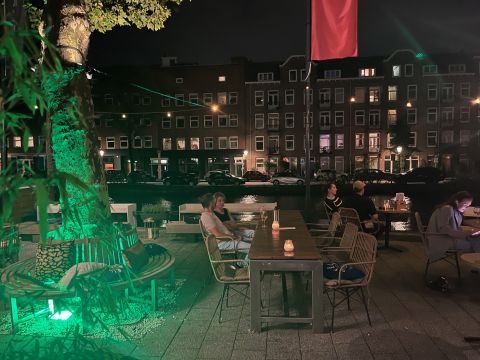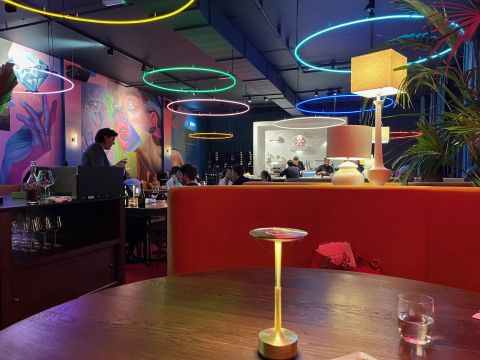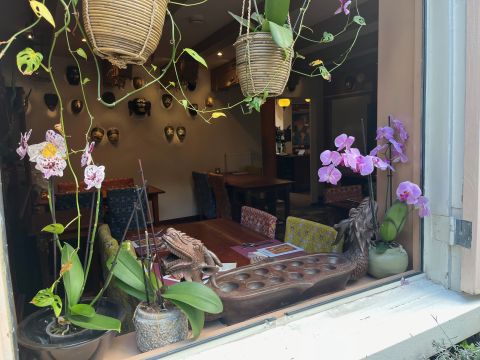Amsterdam and the original Haarlem

Nick searched for Indonesian food while Jancis celebrated a special anniversary. Above, one of the many outdoor restaurants in the main square in Haarlem.
My intention was clear and, I believe, extremely honourable.
I would use our 48 hours in Amsterdam and Haarlem to investigate and enjoy Indonesian food. The relationship between Holland and Indonesia, once known as the Dutch East Indies, is close to 350 years old. The restaurants, and their individual, spicy style of cooking, are one of the few lasting benefits of colonialism, similar in many respects to the United Kingdom’s plethora of Indian and Chinese restaurants, and to France’s numerous Vietnamese restaurants. Dishes such as beef rendang, nasi goreng and many much spicier renditions have long been widely available in Holland.
My quest began promisingly. The taxi ride from Schiphol airport to the Amsterdam restaurant that had been highly recommended was no more than 10 minutes. Just after 9 pm we were climbing the stairs to the Daalder restaurant, past the canal close by and tables beside it where the restaurant serves a menu of ‘street food dishes’.
Inside we were struck by an extremely eye-catching design. The right-hand side comprises a run of large circular tables capable of seating as many as eight, or 10 at a pinch. Smaller tables for twos are across the centre and to the left. By the entrance is a large service table which serves many functions. At the front are the cheeses, all under glass cloches. Then, below, is a vast glass storage, with plenty of room for open bottles, and numerous wines being served by the glass on top. The restaurant has been most thoughtfully designed.
Mirrored but not exactly above the round tables is a series of circular overhead lights, all varied colours, which add to the fun, as do the murals on the far wall. As though this was not enough visually there is an open kitchen at the far end, painted entirely white – other than the red Michelin star which Daalder has earned, which stands proudly above the chefs. There seems to be an ever-changing roster of chefs, with those not on active service standing off to the right.
We were extremely hungry and thirsty. A couple of menus were delivered, one à la carte, the other the long set menus, the Daalder experience for €145 or the even longer ‘chef’s favourites’ for €225 which we quickly set aside. A very thick volume containing the wine list was brought with considerable pride by Saskia Smeenk, their highly experienced sommelier.
JR opened the wine list and was immediately struck on page two by a cleverly located list of bin ends. She decided a Saumur-Champigny from Château Yvonne 2017 at €80 would go happily with whatever we ate and ordered it. This was despite the sommelier’s attempt to dissuade her. Would she not like to look at the wines by the glass? Perhaps the page devoted to wines made by female winemakers (under the heading ‘in the mood for a touch of femininity’)? Or perhaps the range of sakes which Smeenk has put together after many years working in a Japanese restaurant? Jancis held firm: the wine arrived, slightly cool, and was delightful both on its own and with the food we ordered.
As a first course, JR ordered the ‘hamachi harmony’ which brought a smile of delight to her face when the waiter announced it was on a bed of ajo blanco. I chose the pulpo classic, small pieces of octopus topped with myriad unannounced mushrooms on a bed of fregola but, more crucially, diced grapefruit for acidity and sliced celery for the much-needed crunch.
Then came the highlight of our meal. It is a continual dilemma for any chef to know when to serve the bread course: too early and it fills the customer up and minimises his/her appetite for dessert. Our hunger had been staved off by an amuse bouche meringue made from sushi rice, topped with diced salmon and furikake, the crunchy Japanese spice mixture, but here it was severely tested when a chef brought two round, bread/brioche/croissant creations with the most luxurious serving of butter. It was a fabulous combination, almost enough for me to say thank you very much and please may I have our bill?
JR ordered ‘lobster dream’ as her main course while I ordered the cod with a hollandaise Pernod and a salad of fennel. This was good but a little lacking contrast, the softness of the fish’s flesh mixing all too easily with the rest of the dish. We finished in style with a Daalder ‘stroopwafel’, a creamy biscuit stuffed with caramel and sea-salt ice cream cleverly presented on a bed of broken biscuits in a blue biscuit tin. And a bill of €235.
Daalder is a restaurant I will happily return to, to explore its menu in less of a hurry and in greater detail. Above all to put its excellent sommelier to work rather than just asking her to bring us a bottle. And also I would return to enjoy one further aspect of the restaurant – the view from the front door of the canal and the houses beyond at 10.45 pm. This is most magical.
Readers may have noticed the absence of much Indonesian input into this meal and for me that was its only disappointment. I vowed to make up for this omission the next day in Haarlem.
But in this I was none too successful. There was no trace of any spice in the otherwise excellent breakfast at the ML Hotel despite the fact that the 17th-century burghers whose portraits graced the walls must have owed their fortunes to their stakes in the Dutch East India Company. I chose to eat in the only Indonesian restaurant in Haarlem that was open for Sunday lunch, the appropriately named Little Jakarta. It’s not quite a restaurant. All the food is pre-cooked and in trays in front of you. You order from a printed menu and the Indonesian woman behind the counter finishes the dish in the microwave. Chicken curry, fried rice and, best of all, green beans with tofu were good and with a can of coconut juice came to a total of €16.
Where I would like to have eaten – and had planned on taking JR had she not been engaged in the 50th anniversary celebrations of the Dutch Wijnacademie – was to De Lachende Javaan (The Laughing Javanese), a long-established Indonesian restaurant in Haarlem. But its opening hours, from 16.30 every afternoon except Monday, did not suit. Looking through this restaurant’s window (above) was the closest I came on this occasion. Eating here provides me with yet another excellent reason for returning to the utterly beguiling Haarlem.
The town’s charms were reinforced on the Sunday evening by a five-course dinner in the nave of the former Catholic now Protestant church of St Bavo, arranged to mark the anniversary. In this church is a truly magnificent organ, its portrait in the National Gallery, London. Handel played it twice, in 1740 and 1750, and Mozart once, in 1766, at age 10.
We were treated to a brief surprise recital just before eating. The nearby Moustique restaurant cleverly cooked, served (above) and, most professionally, delivered the inventive menu and many bottles of wine, the highlight of which was a magnum of Château Giscours 2005, generously donated to each table by the property’s Dutch general manager Alexander van Beek, husband of Véronique Sanders of Château Haut-Bailly.
At the dinner were numerous men and women from the world of wine in Holland from whom I learned the following: that Heimat in Utrecht is the hottest new restaurant; that The Hague has perhaps the highest concentration of Indonesian restaurants; and, from someone who had accidentally swallowed a mouthful of the fiercest Indonesian spice mixture, that a mouthful of sugar is the most effective antidote. Useful information for my return visit.
Daalder Postjesweg 1, 1057 DT Amsterdam, The Netherlands; tel: +31 (0)20 624 8864
Moustique Oude Groenmarkt 8, 2011 HL Haarlem, The Netherlands; tel: +31 (0)23 532 9251
De Lachende Javaan (The Laughing Javanese) Frankestraat 27, 2011 HT Haarlem, The Netherlands; tel: +31 (0)23 532 8792
Heimat Biltstraat 48, 3572 BC Utrecht, The Netherlands; tel: +31 (0)30 785 9839
Photo at top by Benedek via Getty Images.
Every Sunday, Nick writes about restaurants. To stay abreast of his reviews, sign up for our weekly newsletter.
Become a member to view this article and thousands more!
- 15,406 featured articles
- 274,929 wine reviews
- Maps from The World Atlas of Wine, 8th edition (RRP £50)
- The Oxford Companion to Wine, 5th edition (RRP £50)
- Members’ forum
- 15,406 featured articles
- 274,929 wine reviews
- Maps from The World Atlas of Wine, 8th edition (RRP £50)
- The Oxford Companion to Wine, 5th edition (RRP £50)
- Members’ forum
- Commercial use of our Tasting Notes








